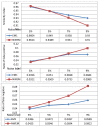Spatial based expectation maximizing (EM)
- PMID: 22029864
- PMCID: PMC3219670
- DOI: 10.1186/1746-1596-6-103
Spatial based expectation maximizing (EM)
Abstract
Background: Expectation maximizing (EM) is one of the common approaches for image segmentation.
Methods: an improvement of the EM algorithm is proposed and its effectiveness for MRI brain image segmentation is investigated. In order to improve EM performance, the proposed algorithms incorporates neighbourhood information into the clustering process. At first, average image is obtained as neighbourhood information and then it is incorporated in clustering process. Also, as an option, user-interaction is used to improve segmentation results. Simulated and real MR volumes are used to compare the efficiency of the proposed improvement with the existing neighbourhood based extension for EM and FCM.
Results: the findings show that the proposed algorithm produces higher similarity index.
Conclusions: experiments demonstrate the effectiveness of the proposed algorithm in compare to other existing algorithms on various noise levels.
Figures













References
-
- Chang PL, Teng WG. "Exploiting the self-organizing map for medical image segmentation". Twentieth IEEE International Symposium on Computer-Based Medical Systems. 2007. pp. 281–288.
-
- Jan J. Medical image processing, reconstruction, and restoration: concepts and methods: CRC. 2006.
-
- Tian D, Fan L. "A Brain MR Images Segmentation Method Based on SOM Neural Network". The 1st International Conference on Bioinformatics and Biomedical Engineering. 2007. pp. 686–689.
-
- Jiang Y, Meng J, Babyn P. "X-ray image segmentation using active contour model with global constraints". 2007. pp. 240–245.
-
- Balafar MA. "New spatial based MRI image de-noising algorithm". Artifitial Intelligence Review. 2011. pp. 1–11.
MeSH terms
LinkOut - more resources
Full Text Sources

